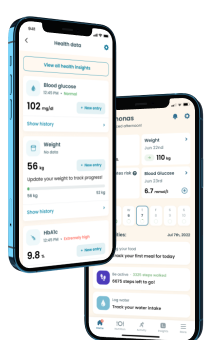Exercise and Diabetes: Diabetes Management Through Physical Activity

Diabetes is a common problem in both youths and adults. In the United States alone, the annual stats on how many people have the disease continues to surge sporadically. According to the National Diabetes Statistics Report, 2020 by CDC, about 1 in 10 Americans have diabetes — a whopping 34.2 million. Similarly, around 1 in 3 American adults have prediabetes, which translates to 88 million US adults.
Many factors may cause diabetes, including genetic and environmental factors. However, the reality is that, regardless of the causative factor, all cases demand a high level of attention. There are several ways to successfully and effectively manage diabetes, and exercise is one.
The focus of this article is to help you harness the health benefits of aerobic activity for better diabetes management.
The Nature of Diabetes

Source: Healthline
The National Institute of Diabetes and Digestive and Kidney Diseases (NIDDK) broadly defines diabetes as a condition that occurs due to excessively high blood glucose/sugar levels. Diabetes is highly likely to happen when there is a lack of enough insulin in the body, and a patient does not complement the shortage by taking insulin treatments or other solutions. It may also be due to the ineffective use of insulin by the body.
Diabetes, irrespective of the stage or type, is a severe condition that could lead to heart disease, kidney disease, stroke, narrowing of the blood vessels, and many other damages. In the worst scenario, diabetes could lead to death.
Excessive carbohydrate intake and other non-genetic factors could trigger high blood pressure. Hence, you must regularly check your blood sugar levels to know the state of your condition and determine if you need blood glucose control.
Generally, if your body weight or body mass index (BMI) falls on the higher side of the scale, you must check your blood sugar to know if you already have diabetes or are at risk of having it.
To check your blood sugar level, it’s best to consult a professional health provider to carry out the test to ensure you are sure of the condition, the extent of damage and knows how to manage it with exercise or other means.
The Types of Diabetes
According to the American Diabetes Association (ADA), the three major types of diabetes are:
Type 1 diabetes primarily occurs in kids and young adults when the body produces very little to no insulin due to autoimmune destruction of the insulin-producing pancreatic beta cells. Patients would need daily insulin injections for health sustenance and survival. Type 1 diabetes and exercise may not be an ideal combo as there isn’t enough insulin that would otherwise be exploited by healthy physical conditioning.
Type 2 diabetes is more common in middle-aged and older people and is due to environmental and genetic factors. In this case, the body produces insulin, but there’s inherent insulin resistance — the body can’t use insulin efficiently. Exercise and type 2 diabetes go hand in hand as aerobic activity is one of the established means of naturally managing the condition.
Gestational diabetes happens in some pregnant women but disappears following childbirth. However, women who have had this form of diabetes are more predisposed to developing type 2 diabetes in the future.
Exercise and Diabetes: An Overview
Diabetes and exercise are two terms that are commonly associated with each other since the latter can be successfully used to manage the former. The American Diabetes Association (ADA) recommends 150 minutes of moderate-intensity exercise weekly for optimal diabetes management.
While you may be tempted to think that this applies to strictly aerobic exercise, the reality is that it’s not the only exercise program that you could opt for. Other programs offer significant health benefits for diabetics, including lower blood pressure and heart disease prevention. To determine the appropriate exercise for your condition, it’s essential to know the extent or nature of your diabetes by checking your blood sugar levels.
The philosophy behind physical activity and diabetes control is true. You can enjoy all the benefits that it brings in improving your wellbeing, reducing insulin insensitivity or insulin resistance, and ensuring a sustained diabetes management solution. We’ll throw more light on exactly how this works and the best exercise programs to engage in for optimal blood sugar levels.
Exercise and Diabetes: The Benefits of Physical Activity in High Blood Sugar Level Management
A significant benefit of physical activity in tackling diabetes is that it lowers the HbA1c (glycated hemoglobin) percentage point—a blood sugar marker—in people with the condition. This health benefit was confirmed to be true for every ethnic group. Remarkably, when paired with complementary diabetes management solutions such as dieting and autonomic therapy, patients who included exercise in their program presented better blood sugar control than those who didn’t.



Resistance exercise, aerobic exercise, or combined training (mix of aerobic exercise and resistant exercise) reduces insulin resistance in adults who had previously been recorded to be at risk of diabetes due to poor insulin creation.
People with diabetes who were recorded to have walked briskly or performed moderate exercise for up to 8 hours a week had lesser risks of heart disease. Those who exercised for the same time but with a higher intensity were found to have an even lesser chance of contracting heart disease.
Diabetic women who were recorded to have spent up to four hours a week on moderate exercise or vigorous activity were stated to have a 40% lesser risk of heart disease compared to those who did not do exercise at all. The results remained consistent despite adjustments in BMI and other factors.
Overall, exercise has proven beneficial in managing diabetes via various means. While it’s widely known as a natural method to lose weight, its benefits in complementing treatment options as well as an independent solution have helped people with diabetes better manage their situation.
In addition, people taking insulin with an incorporated exercise program are more likely to feel better faster as the body ensures there’s always enough insulin, irrespective of diabetes.
The Best Exercise Programs for People With Diabetes (High Blood Glucose Levels)

Source: Fitness Index
Having considered the health benefits of exercise, we now look at the best ones you can harness to manage your situation. However, it’s important to note that the type of exercise you chose would most likely depend on your carbohydrate intake, high and low blood sugar levels, alongside other vital metrics.
Moderate Intensity Physical Activity
For those whose condition isn’t severe but are at risk of having diabetes, a mix of moderately intense physical activity and other diabetes management options is the best way to control and prevent the condition. If you’re fond of constant snacking or drinking artificial sugar-filled fruit juice, you may also need to reduce your intake.
This type of exercise usually includes brisk walking for not more than an hour, light jogs, and 15 to 20 minutes of exercise daily. The great thing about this exercise is that it prevents dehydration while controlling blood pressure and sugar level. For example, walking briskly not only helps control high blood sugar levels but also helps prevent low blood sugar levels since it keeps your heart pumping.
While most people with diabetes are focused on avoiding high blood sugar levels, low blood sugar levels are equally a severe health concern. If you’re under medical care such as insulin dose, cholesterol medications, Glyburide (glibenclamide), and other related treatments, low blood sugar could cause blackouts and worse consequences.
To maximally benefit from this exercise program, you may have to adjust your diet to one that keeps your body weight in the best condition. This includes drinking water, natural fruit juice, and eating food with more fiber than sugar.
High-Intensity Interval Training
High-intensity interval training exercise is simply a more extreme version of the moderate intensity program and could include running, sprinting, and using glucose tablets for energy. This program is great when you have a very high sugar level and desire weight loss. This kind of exercise can go for more than an hour but should not be so extreme that the body breaks down.
Resistance Exercise
Resistance exercise or resistance training is an excellent option for building muscle mass while ensuring you are physically active and fit. Unlike the first two programs that focus on the lower body while controlling sugar levels, resistance training complements them by developing the upper body.
This exercise helps lower blood sugar effectively when done right, so it’s a great option to go for. It includes tai chi training, weight lifting, and other muscle-developing skills.
Conclusion
The American Diabetes Association (ADA) has confirmed exercise to be an effective solution for managing diabetes. Moreover, with the help of human services (a trainer), you could harness the benefits that it offers to the maximum.
You should, however, be prepared before choosing any exercise program. Drinking water is essential to ensure a corrective relationship between diabetes and exercise, and you must also get comfortable athletic shoes for starters. You could also opt for a time and calorie counter to know how many calories you burn daily.
Our revolutionary app, Klinio, also makes your exercise routine more seamless by offering no-equipment beginner workouts with customizable activity levels, ability, and pace. It also provides a detailed weight loss progress and blood sugar levels tracker to help you get the best out of your exercise routines. In addition to that, it features an ever-evolving meal plan that can help you stick with the best diet suited for people with diabetes undergoing exercise.
Take a quiz and get your diabetes-management plan today!









